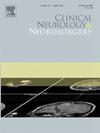Stabbing injury of the spinal cord: A case report and systematic literature review
IF 1.8
4区 医学
Q3 CLINICAL NEUROLOGY
引用次数: 0
Abstract
Background
Spinal cord injury caused by stab wounds (SCISW) represents one of the rarest causes of traumatic spinal cord injury. Because of their rarity, management of such cases may be challenging due to the lack of specific guidelines.
Methods
The systematic review was performed on 30th June 2024 according to the PRISMA 2020 guidelines. A literature search was conducted across four databases: PubMed, Scopus, Web of Science, and The Polish Medical Bibliography. Additionally, a unique case was presented as an illustrative clinical presentation.
Results
A total of 89 eligible articles, including 78 case reports (89 patients) and 11 case series (882 patients), were found. The current report describes a case of a 41-year-old man with one neck stab wound and a stab wound of the chest. Clinical examination demonstrated complete paraplegia and a lack of sensation below the level of T1. Magnetic resonance imaging (MRI) showed a complete transection of the spinal cord at the T1-T2 level. Due to the lack of foreign bodies at the injury site, the patient was managed conservatively.
Conclusion
Direct stabbing injuries rarely lead to complete transection of the spinal cord as in our case. Computed tomography (CT) scans or plain radiographs are necessary to exclude retained foreign bodies. MRI as a further imaging tool can confirm the SCI and may be useful as a predictor of outcomes. Regarding optimal management, conservative treatment should be preferred over surgical intervention in the absence of a foreign body at the injury site.
脊髓刺伤:病例报告和系统文献综述。
背景:刺伤导致的脊髓损伤(SCISW)是外伤性脊髓损伤中最罕见的原因之一。由于其罕见性,此类病例的处理可能因缺乏特定指南而具有挑战性:该系统性综述于 2024 年 6 月 30 日根据 PRISMA 2020 指南进行。在四个数据库中进行了文献检索:PubMed、Scopus、Web of Science 和《波兰医学书目》。此外,还提供了一个独特的病例作为临床表现的例证:结果:共找到 89 篇符合条件的文章,包括 78 篇病例报告(89 名患者)和 11 篇系列病例(882 名患者)。本报告描述了一例 41 岁男性的病例,患者颈部有一处刀伤,胸部也有一处刀伤。临床检查显示他完全截瘫,T1 水平以下无知觉。磁共振成像(MRI)显示 T1-T2 水平脊髓完全横断。由于受伤部位没有异物,患者接受了保守治疗:结论:直接刺伤很少会导致脊髓完全横断。计算机断层扫描(CT)或普通X光片是排除异物残留的必要手段。核磁共振成像作为一种进一步的成像工具,可以确认脊髓损伤,并可用于预测预后。关于最佳治疗方法,如果损伤部位没有异物,应首选保守治疗,而不是手术干预。
本文章由计算机程序翻译,如有差异,请以英文原文为准。
求助全文
约1分钟内获得全文
求助全文
来源期刊

Clinical Neurology and Neurosurgery
医学-临床神经学
CiteScore
3.70
自引率
5.30%
发文量
358
审稿时长
46 days
期刊介绍:
Clinical Neurology and Neurosurgery is devoted to publishing papers and reports on the clinical aspects of neurology and neurosurgery. It is an international forum for papers of high scientific standard that are of interest to Neurologists and Neurosurgeons world-wide.
 求助内容:
求助内容: 应助结果提醒方式:
应助结果提醒方式:


